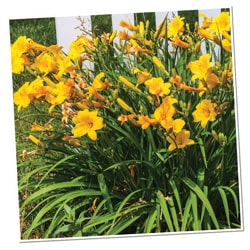Color is a powerful tool in garden design – adding interest and even evoking emotion. Warm colors (red, orange, and yellow) promote excitement, while cool colors (green and blue) are calming.
Color may also be used to create greater depth in a planting – dark colors appear to move away from the viewer, while bright colors stand out.
Understanding how colors work together and interact with the human eye assists in using color effectively in the landscape. Following are tips for utilizing color in creating a pleasing monochromatic or single-color design.
Tints and Shades
A garden planted using a monochromatic color scheme includes flowers and foliage in several tints and shades of a main hue. A hue is the base color utilized in the design, such as red, yellow or purple. Tints are lighter versions of the hue, while shades are darker versions.
You can use any color to create a monochromatic color scheme, but remember the ways color influences emotion, and select a color that matches the desired mood. A blue garden, for example, can provide a serene respite at day’s end.
White monochromatic plantings are commonly used to create a sense of elegance and simplicity. In addition to white blossoms, silver foliage is often included in the design. White gardens are sometimes referred to as moon gardens since the flowers and silver foliage glow in the moonlight. White is an excellent choice if you primarily utilize your landscape in the evening.
Texture and Form

In a monochromatic planting, we must rely on something other than color to create visual interest. In this setting, texture and form become the stars. We can create accents and focal points using coarse texture and bold forms.
For example, the balloon-sized blossoms and large leaves of ‘Big Daddy’ Hydrangea visually leap forward among more fine-textured plants in a blue-colored design. Similarly, we might rely on the richly-hued ‘Black Ripple’ Colocasia to create interest in a purple-themed planting.
Sources of Color

When we think of using color in the landscape, we most commonly think of flowers. But flowers blossom and fade – their color is fleeting. When we plan for color, we need to think beyond the blossom.
Consider all levels of the garden, from the groundcover to the canopy, when selecting elements of color. And plan for a full season of color, with evergreen foliage and seasonal fruits or colorful autumn foliage and showy bark.
Foliage is our greatest source of garden color offering a great range of hues from the emerald green of LeAnn™ Cleyera to the chartreuse ‘Lemon Lime’ Nandina and maroon Red Diamond™ Midsize Loropetalum.
Variegation also supports monochromatic color schemes. The golden variegation of Miss Lemon™ Abelia reinforces a yellow-based garden, while the white-variegated ‘Meerlo’ Lavender would enhance the evening glow of a moon garden.
As we select plants for a monochromatic color scheme, the foliage becomes key, providing continuity through the seasons.
Consider these plant combinations as a starting point for monochromatic designs:
Burgundy

|

|
Yellow

|

|

|







